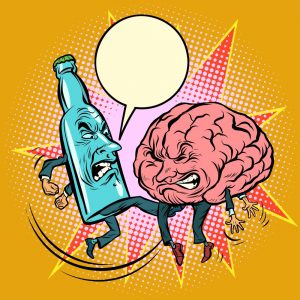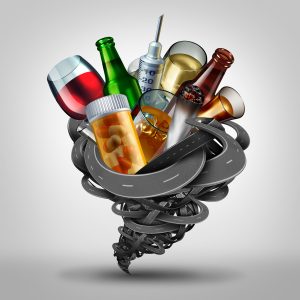April is Alcohol Awareness Month. This month is dedicated to raising awareness of the prevention, intervention and treatment of alcohol-related problems among all ages. Since 1987, the National Council on Alcoholism and Drug Dependence (NCADD) sponsors this month to help people understand the struggles of those living with alcoholism. A bit of education goes a long way in recognizing this disease and its impact on individuals, families and society at large.
Let’s start by reviewing some sobering statistics about alcoholism in our country. They are eye opening!
Facts and Figures about Alcoholism
According to the 2015 National Survey on Drug Use and Health (NSDUH), an estimated 88,000 people die every year from alcohol-related causes. It’s the third leading preventable cause of death in the U.S., next to smoking and poor diet/lack of exercise. Here are a few more discoveries from the survey.
- 4 percent of people 18 and over reported drinking alcohol at some point in their lifetime.
- 70 percent of people 18 and over said they drank within the last year, and 56 percent reported drinking within the last month.
- 1 million adults 18 and over have AUD, but less than seven percent received treatment.
- 623,000 adolescents between the ages of 12-17 have AUD, with roughly five percent receiving treatment.
- Alcohol misuse cost the U.S. $249 billion in 2010, with most of the cost going toward binge drinking.
Understanding Alcohol Use Disorder
Alcohol abuse and alcohol dependence have been combined into one disorder called alcohol use disorder, or AUD. A person can have AUD without having alcoholism, though the risk for alcoholism progresses as your tolerance increases.
AUD is defined as a pattern of alcohol abuse that continues even when problems arise. You might have trouble controlling your drinking or be preoccupied with drinking. However, only a medical professional can diagnose you with AUD, as it’s based on certain criteria that you must meet. There are different levels of AUD that include mild, moderate and severe. Usually, when a person is severe, they already have alcoholism and require alcohol rehab in California.
The common signs and symptoms of AUD are:
- Increased tolerance
- Loss of control
- Lack of desire to stop
- Continued use despite negative consequences
- Withdrawal symptoms when abstaining
Alcohol use disorder needs intervention and treatment. Without it, this pattern of behavior can progress into full blown alcoholism which is harder to treat.
When Alcohol Becomes a Problem
One of the hardest parts about alcohol is that the lines are blurred between what’s “normal” and “not normal.” Alcohol is socially acceptable and found in restaurants, bars, nightclubs, movie theaters, coffee shops, retail environments – everywhere!
It’s normal for people to grab a drink after work or get buzzed at a wedding. Many people even have their first experience with alcohol before they are 21. So how can a person tell when alcohol use has crossed the line into something more dangerous?
Drinking problems do not develop overnight. They develop over time, which is why Alcohol Awareness Month is educating people on the signs and symptoms of alcohol use disorder. A person does not have to have full blown alcoholism to need help. Abusing alcohol on a regular basis puts a person at risk for alcoholism down the road. It could take them many years to get there, or a single stressful event could bring them to this point.
Also Read: Is Alcoholism a Disease or a Moral Failing?
Diagnosing Alcohol Use Disorder
In order to be diagnosed with AUD, a person has to meet certain criteria. The Diagnostic and Statistical Manual of Mental Disorders (DSM-5) has assigned three levels of severity to diagnose AUD. They include:
- Mild: two or three symptoms
- Moderate: four or five symptoms
- Severe: six or more symptoms
Here are some signs that an alcohol use disorder is present.
- Cravings for alcohol
- Inability to cut down
- Growing tolerance for alcohol
- Participation in drinking-related activities
- Suffering work or school performance
- Issues in relationships
- Neglecting child and household care
- Experiencing withdrawal symptoms
How Difficult is it to Quit Drinking?
Months like Alcohol Awareness Month remind people that it’s never too late to turn your life around. By making the decision to quit drinking today, you can significantly improve your health and well-being. Imagine being free of alcohol and the power it has over you. Imagine being able to find true happiness in your life without needing alcohol to bring you temporary numbing.
Quitting alcohol is like quitting other drugs – it’s difficult but not impossible. People do it every day. You will go through a brief period of withdrawal, but once the alcohol is out of your system, you can begin working through counseling and the 12 steps. Fortunately, you are not alone in your journey. There are treatment centers like Pax House Recovery that are here to help.
The steps to quitting drinking are as follows:
- We recommend medically supervised drug detox in California. Withdrawal from alcohol can be so severe, it can be fatal. Please do not attempt this on your own. A medically supervised detox center will ensure a safe and effective detox process.
- When the detox process is complete, treatment begins. It takes time for the brain to heal and go back to normal, so you must learn to live without your vice. Counseling tackles this by helping you cope with stress, confront past trauma, repair relationships, build life skills and more.
- Continuing care. After completing treatment in an inpatient or outpatient rehab in Pasadena, you will begin building your new, sober life. Continuing care is important and includes attending 12-step meetings, working with a sponsor and more.
Pax House Recovery offers alcohol treatment in Pasadena for people with alcohol-related problems. We often find that people with alcoholism suffer from low self-esteem, low self-worth and co-occurring disorders like anxiety and depression. Alcoholism also tends to run in families, so children who are raised with alcohol in the home are more likely to have problems, too. We’ve seen it all, and we can help you or a loved one, too. Contact us today to learn more.








